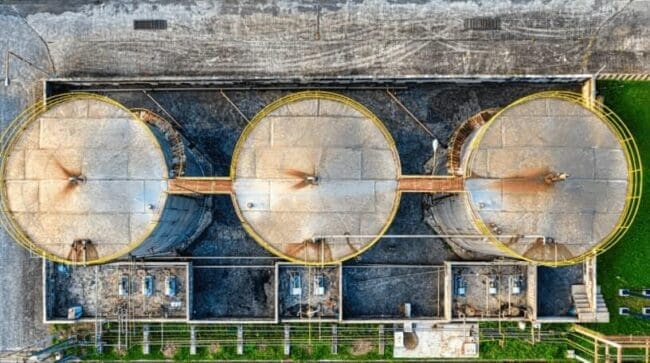Climate investment takes businesses to true net zero

Climate investment is a necessary – but tricky – waypoint on the path to net zero. Here’s what climate investment is, why it’s needed, and how to spot high-quality options.
More businesses than ever before are committing to reaching net zero emissions by 2050 in alignment with the Paris agreement.
These commitments contribute to limiting global temperature rise to 1.5°C, which will mitigate some of the worst consequences of climate change. Businesses with net zero strategies also have an easier time attracting capital and talent, and experience increased interest from customers.
To reach net zero, climate investment (a form of carbon compensation) is a necessary endeavor – but also a risky one, as businesses try to navigate an industry that’s fraught with incomplete information and greenwashed “offsetting.”
What is climate investment?
A business engages in climate investment when it pays to remove carbon from the atmosphere to compensate for its greenhouse gas emissions.
Climate investment is the final stage of the journey to net zero emissions.
Businesses committed to Paris-aligned net zero targets should begin by reducing their carbon emissions. Most businesses can’t completely eliminate their carbon footprint, so after minimizing their emissions they will need to engage in climate investment to compensate for the residual emissions.
How to distinguish high-quality climate investment from greenwashed offsetting
Navigating between different methods of carbon offsetting can be difficult, and while definitions of “climate investment” and “carbon offsetting” may look similar, the difference lies in their effectiveness.
Today, “carbon offsetting” has become associated with businesses that buy cheap offsets that give the appearance of carbon neutrality without truly achieving it. One of the most common examples of these ineffective offsets is tree planting. Many schemes allow companies to offset emissions by planting trees that theoretically absorb equivalent CO2 from the atmosphere – but newly planted trees can take decades to capture the emitted carbon. Meanwhile, the carbon emissions they’re meant to compensate for are instantaneous.
This isn’t always done maliciously: businesses may believe they’re truly compensating for their carbon footprint. A lack of standardization and legal definition means that carbon offsetting is largely an unregulated frontier.
Besides being ineffective at mitigating climate change, low-quality carbon offsetting also results in a host of risks for companies engaging in it, from damages to reputation – like being accused of greenwashing – to the possibility of having to redo insufficient offsets as new legislative standards are passed.
In other words, cheap offsetting isn’t a bargain, but rather a way of taking on climate debt that will come due in the future.
Normative offers high-quality climate investment to help you reach true net zero
Our Carbon Removal Portfolio features evidence-based carbon sinks and removal.
To ensure you’re using high-quality climate investment, options should be evaluated on four metrics: additionality, permanence, double-counting, and leakage.
- Additionality – the climate investment will lead to a reduction of greenhouse gas emissions that would not have happened otherwise.
- Permanence – the climate investment will result in a quantifiable piece of carbon being kept out of the air forever.
- Double-counting – the same investment is not sold multiple times.
- Leakage – ensuring the investment will not lead to negative consequences elsewhere.
Related concepts
Avoided emissions
Avoided emissions refer to greenhouse gas emissions that are prevented from being released into the atmosphere as a result of more efficient goods and services replacing less efficient methods.
Sometimes referred to as “scope 4” or “carbon handprint,” avoided emissions may be achieved through measures such as energy efficiency improvements or switching from fossil fuels to renewable energy sources.
At the moment, there are no universally recognized standards to account for avoided emissions. The GHG Protocol states that avoided emissions should not be considered when accounting or compensating for scope 1, 2, and 3 emissions.
Nature-based solutions
Nature-based solutions are the conservation and management of natural ecosystems – such as forests, wetlands, and grasslands – which can act as carbon sinks that absorb and store greenhouse gas emissions from the atmosphere.
The benefits of nature-based solutions can include biodiversity conservation, improved livelihoods for local communities, and co-benefits such as improved water quality and soil conservation.
It’s important to note, however, that the reliability of nature-based solutions for carbon sequestration can vary greatly. This is due to factors such as unpredictable or temporary carbon sequestration (such as trees being cut down after they are planted), as well as the complexity and cost of monitoring and verifying the carbon sequestered.
Examples of nature-based solutions include:
- Reforestation – planting new trees to replace those that have been cut down; creating new forests that can absorb carbon dioxide from the atmosphere.
- Forest conservation – preventing deforestation, which can release large amounts of carbon dioxide into the atmosphere.
- Wetland restoration – restoring degraded wetlands, which can store carbon and provide other benefits like water purification and flood control.
Carbon removals / permanent removals
Carbon removals are the actions taken to remove carbon dioxide from the atmosphere. This can include activities such as carbon capture and storage and soil carbon sequestration. Carbon removal is a form of climate investment, and thus, is a reliable way for businesses to work toward net zero.
Examples of carbon removals include:
- Direct air capture (DAC) – specialized machines directly capture carbon dioxide from the air and store it underground.
- Mineral carbonation – combining atmospheric carbon with naturally occurring minerals to form stable carbonates, which can be stored underground.
- Soil carbon sequestration – using practices such as no-till farming, agroforestry, and the use of cover crops to increase the amount of carbon stored in soil.
How businesses use climate investment to reach net zero
Climate investment alone isn’t enough to achieve net zero. It needs to be used in combination with comprehensive carbon accounting and targeted, high-impact carbon emissions reductions.
The first step in bringing your business to reach net zero is to account for all your carbon emissions. This includes not only scope 1 and scope 2 emissions – the direct emissions from your business’s activities – but also the hard-to-measure scope 3, which encompasses the upstream emissions from your supply chain and the downstream emissions of your product lifecycles.
After accounting for your entire carbon footprint and discovering your emissions hotspots, you can set and implement a plan to reduce your business’s carbon emissions, beginning with your biggest sources.
After reducing your carbon emissions to the absolute minimum, you can begin the process of climate investment to compensate for your remaining emissions. Potential climate investments should be evaluated based on the four qualities described above – additionality, permanence, double-counting, and leakage – and vetted by a trusted source, like the nonprofit CarbonPlan.
Executive summary
- Climate investment is necessary to reach net zero, but it must be used in combination with carbon accounting and emission reductions.
- Many carbon offsetting options are less effective than they claim, which results in long-term reputational and financial risks to companies using low-quality offsets.
- To find high-quality climate investments, options should be evaluated on four qualities: additionality, permanence, double-counting, and leakage.
- Normative offers high-quality, evidence-based climate investment to help businesses reach true net zero emissions.
Reach true net zero emissions
With Normative, you can measure your entire carbon footprint and find emissions hotspots. Our climate strategists devise a reduction plan tailored to your needs – and a climate investment strategy to compensate what you can’t reduce.
Climate investment FAQs
What is climate investment?
Climate investment refers to the process by which a business pays for a carbon removal service with the objective to remove carbon from the atmosphere and compensate for its greenhouse gas emissions. Examples of climate investment include carbon removal methods such as mineralization or soil carbon sequestration. Climate investment is seen as the final stage of the journey to net-zero emissions and is a necessary step for businesses that are committed to reaching the global 1.5°C degree target signed by world leaders through the Paris agreement.
Frequently asked questions
What is offsetting?
Carbon offsetting refers to the practice of buying carbon credits which are meant to counteract the emissions produced by an individual or a company. Offsetting is largely unregulated, and some options are ineffective at mitigating climate change.
What is the difference between climate investments and offsets?
Climate investment and carbon offsetting are similar in that they both involve paying to remove carbon from the atmosphere to compensate for greenhouse gas emissions. However, offsetting can often use non-permanent solutions – such as planting trees – which can take decades to absorb the emitted carbon and risk not being as effective as promised. Climate investments, on the other hand, focus on high-quality, evidence-based carbon sinks and removal programs.












